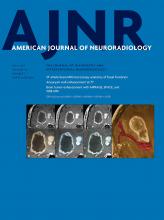Index by author
Coulette, S.
- FELLOWS' JOURNAL CLUBAdult BrainYou have accessDiagnosis and Prediction of Relapses in Susac Syndrome: A New Use for MR Postcontrast FLAIR Leptomeningeal EnhancementS. Coulette, A. Lecler, E. Saragoussi, K. Zuber, J. Savatovsky, R. Deschamps, O. Gout, C. Sabben, J. Aboab, A. Affortit, F. Charbonneau and M. ObadiaAmerican Journal of Neuroradiology July 2019, 40 (7) 1184-1190; DOI: https://doi.org/10.3174/ajnr.A6103
From January 2011 to December 2017, nine consecutive patients with Susac syndrome and a control group of 73 patients with multiple sclerosis or clinically isolated syndrome were included. Two neuroradiologists blinded to the clinical and ophthalmologic data independently reviewed MRIs and assessed leptomeningeal enhancement and parenchymal abnormalities. Follow-up MRIs of patients with Susac syndrome were reviewed and compared with clinical and retinal fluorescein angiographic data evaluated by an independent ophthalmologist. Patients with Susac syndrome were significantly more likely to present with leptomeningeal enhancement: 5/9 (56%) versus 6/73 (8%) in the control group. They had a significantly higher leptomeningeal enhancement burden with ≥3 lesions in 5/9 patients versus 0/73. Regions of leptomeningeal enhancement were significantly more likely to be located in the posterior fossa. The authors conclude that leptomeningeal enhancement occurs frequently in Susac syndrome and could be helpful for diagnosis and prediction of clinical relapse.
Couture, P.
- SpineYou have accessQuantification of DTI in the Pediatric Spinal Cord: Application to Clinical Evaluation in a Healthy Patient PopulationB.B. Reynolds, S. By, Q.R. Weinberg, A.A. Witt, A.T. Newton, H.R. Feiler, B. Ramkorun, D.B. Clayton, P. Couture, J.E. Martus, M. Adams, J.C. Wellons, S.A. Smith and A. BhatiaAmerican Journal of Neuroradiology July 2019, 40 (7) 1236-1241; DOI: https://doi.org/10.3174/ajnr.A6104
Crandall, L.
- FELLOWS' JOURNAL CLUBAdult BrainOpen Access3T MRI Whole-Brain Microscopy Discrimination of Subcortical Anatomy, Part 2: Basal ForebrainM.J. Hoch, M.T. Bruno, A. Faustin, N. Cruz, A.Y. Mogilner, L. Crandall, T. Wisniewski, O. Devinsky and T.M. ShepherdAmerican Journal of Neuroradiology July 2019, 40 (7) 1095-1105; DOI: https://doi.org/10.3174/ajnr.A6088
The authors applied an optimized TSE T2 sequence to washed whole postmortem brain samples (n=13) to demonstrate and characterize the detailed anatomy of the basal forebrain using a clinical 3T MR imaging scanner. Theyidentified most basal ganglia and diencephalon structures using serial axial, coronal, and sagittal planes relative to the intercommissural plane. Specific oblique image orientations demonstrated the positions and anatomic relationships for selected structures of interest to functional neurosurgery.
Crawford, K.
- You have accessAssessment of Explicitly Stated Interval Change on Noncontrast Head CT Radiology ReportsM. Braileanu, K. Crawford, S.R. Key and M.E. MullinsAmerican Journal of Neuroradiology July 2019, 40 (7) 1091-1094; DOI: https://doi.org/10.3174/ajnr.A6081
Criado-hidalgo, E.
- SpineYou have accessSubject-Specific Studies of CSF Bulk Flow Patterns in the Spinal Canal: Implications for the Dispersion of Solute Particles in Intrathecal Drug DeliveryW. Coenen, C. Gutiérrez-Montes, S. Sincomb, E. Criado-Hidalgo, K. Wei, K. King, V. Haughton, C. Martínez-Bazán, A.L. Sánchez and J. C. LasherasAmerican Journal of Neuroradiology July 2019, 40 (7) 1242-1249; DOI: https://doi.org/10.3174/ajnr.A6097
Cruz, J.P.
- LetterYou have accessPolymer Embolism from Bioactive and Hydrogel Coil Embolization Technology: Considerations for Product DevelopmentA.M. Chopra, J.P. Cruz and Y.C. HuAmerican Journal of Neuroradiology July 2019, 40 (7) E34-E35; DOI: https://doi.org/10.3174/ajnr.A6083
Cruz, N.
- FELLOWS' JOURNAL CLUBAdult BrainOpen Access3T MRI Whole-Brain Microscopy Discrimination of Subcortical Anatomy, Part 2: Basal ForebrainM.J. Hoch, M.T. Bruno, A. Faustin, N. Cruz, A.Y. Mogilner, L. Crandall, T. Wisniewski, O. Devinsky and T.M. ShepherdAmerican Journal of Neuroradiology July 2019, 40 (7) 1095-1105; DOI: https://doi.org/10.3174/ajnr.A6088
The authors applied an optimized TSE T2 sequence to washed whole postmortem brain samples (n=13) to demonstrate and characterize the detailed anatomy of the basal forebrain using a clinical 3T MR imaging scanner. Theyidentified most basal ganglia and diencephalon structures using serial axial, coronal, and sagittal planes relative to the intercommissural plane. Specific oblique image orientations demonstrated the positions and anatomic relationships for selected structures of interest to functional neurosurgery.








